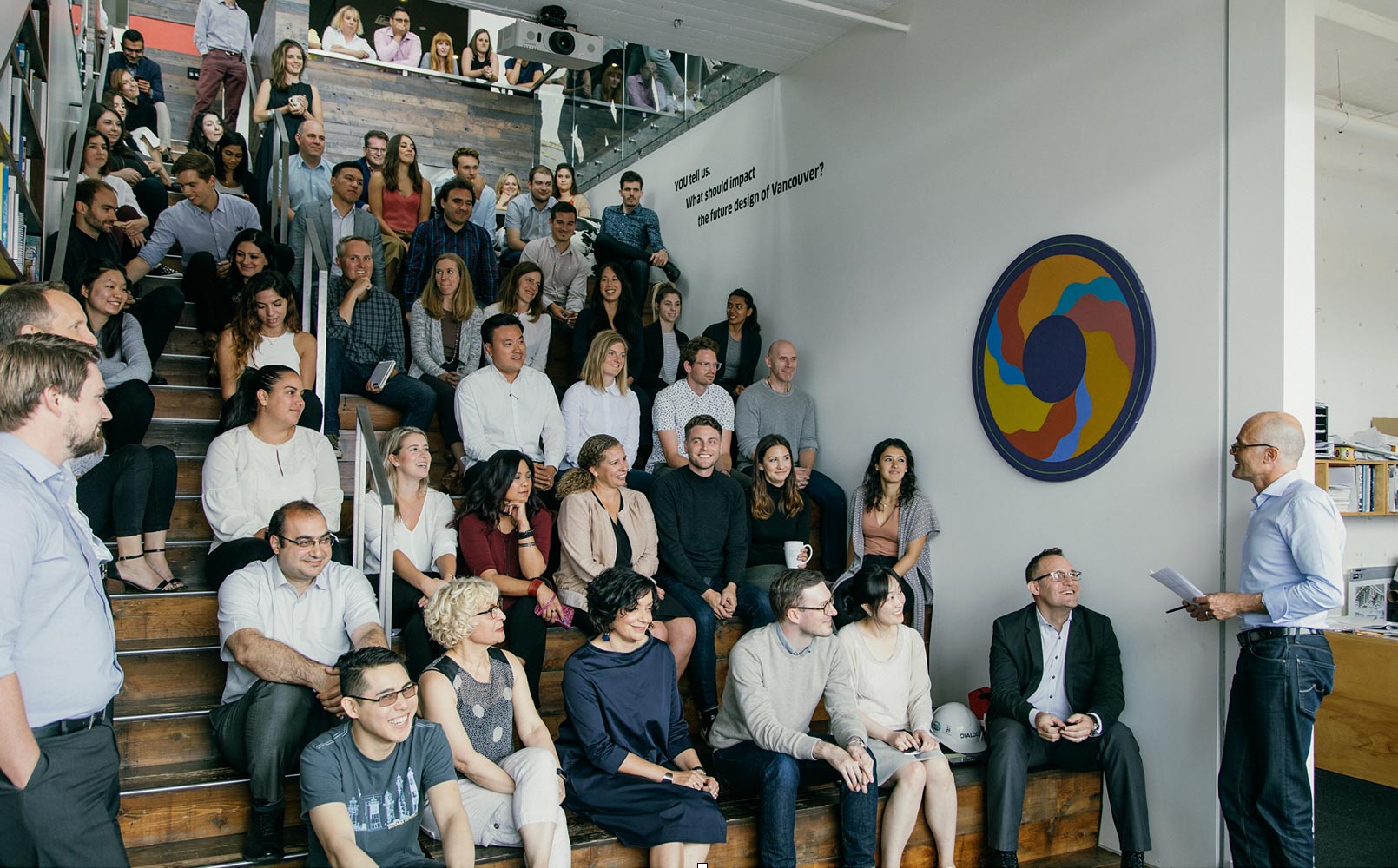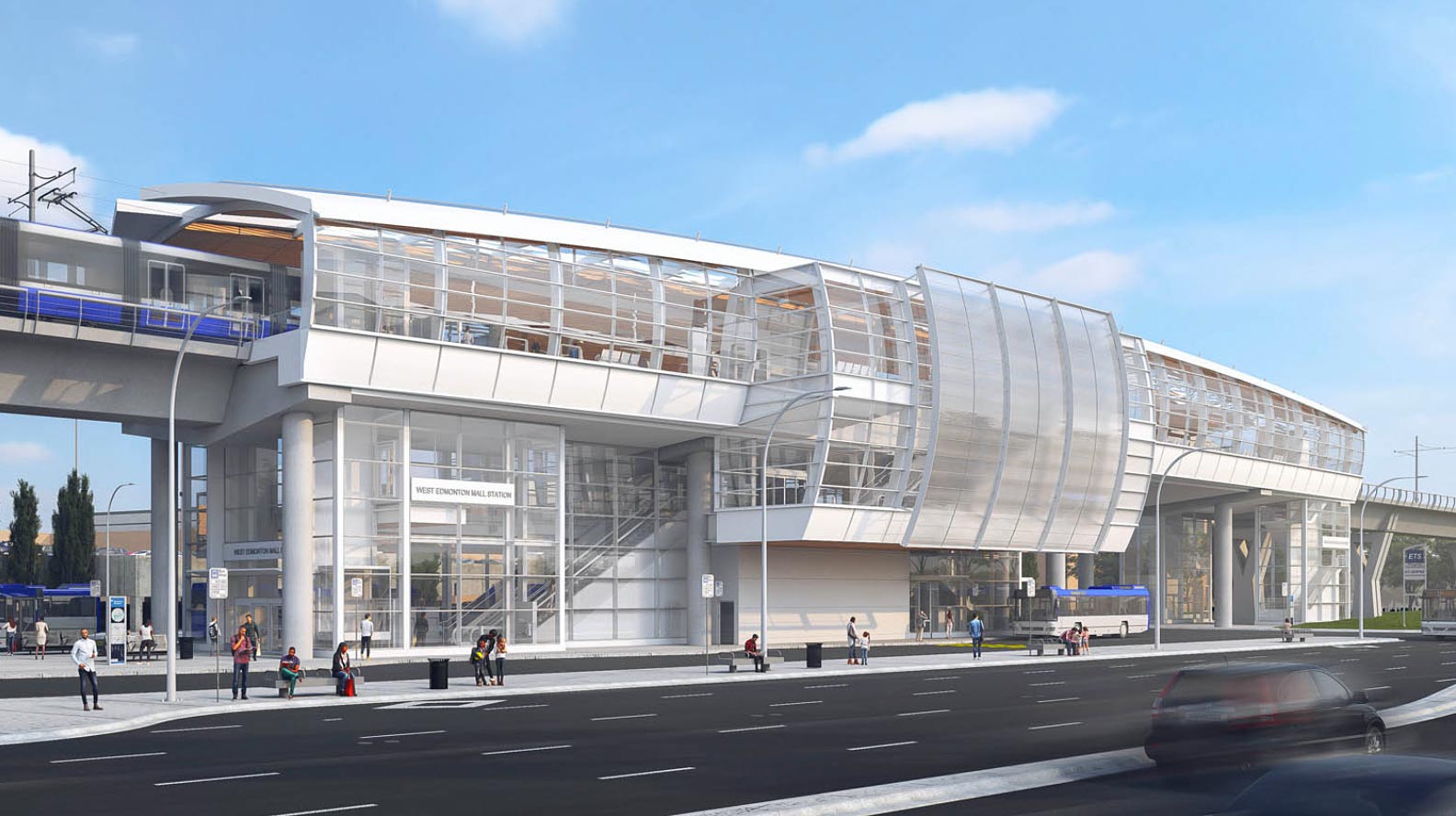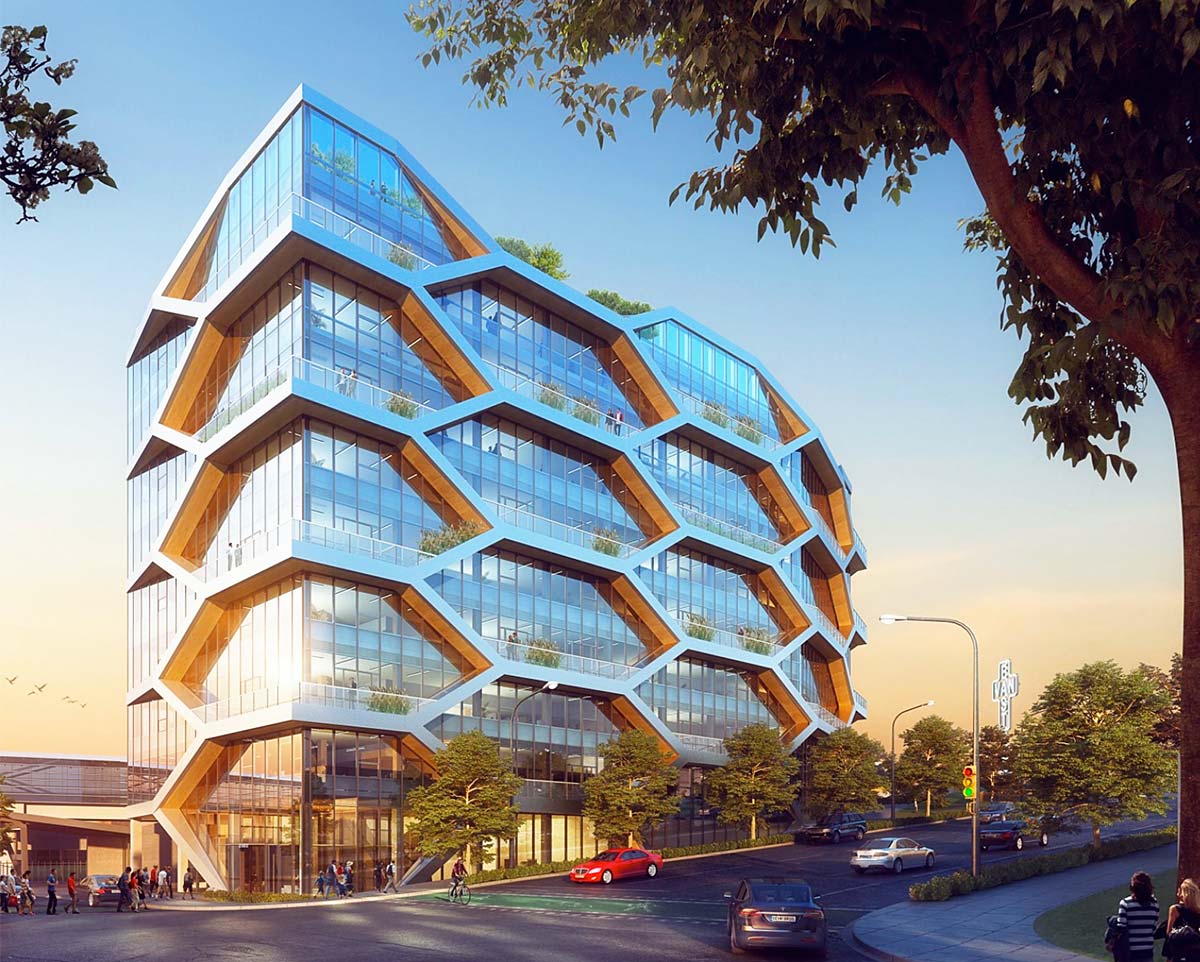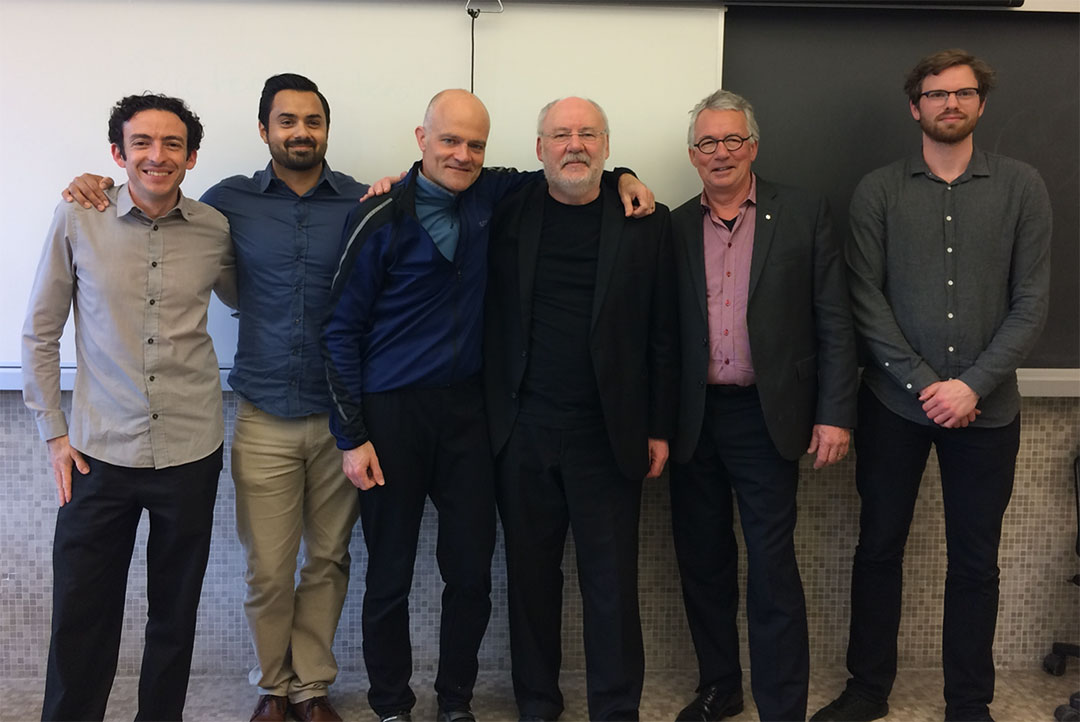“The next generation gives me hope! The wisdom and voice of Greta Thunberg gives me hope – a 16 year old! It gives me hope to hear her voice and to hear the support for her voice. And all the marches across the globe gives me hope for our collective future.”
In this podcast I talk with Martin about his design philosophy, his belief that sustainable design is no longer enough, that we must now be designing to create truly regenerative buildings – buildings that improve the ecosystems they are part of. We also talk about what gives Martin hope when things are looking dark.
Background
Martin is one of those truly inspiring individuals whose energy and enthusiasm for green design is contagious, and he is a magnet to all of the young DIALOGers passionate about learning how to design buildings that improve their environment and make a real difference in reducing CO2 emissions.
He is both a registered architect and a mechanical engineer, and brings over two decades of experience and leadership to the DIALOG’s urban design, mixed-use development, higher education, and transportation projects. He is passionate about developing regenerative design solutions that are socially, economically, and environmentally responsible, with a portfolio of work that has been recognized with awards for planning, architecture, and innovation.
Martin’s recent project work includes the new LEED® Gold certified Campus Energy Centre, the new Exchange Residence, and the Bus Exchange at the University of British Columbia. He led the sustainable design strategy and LEED® certification process on the University of Calgary’s U-District neighbourhood, the largest ND Platinum project in Canada. And he is currently leading the rezoning of the Heather Lands, a 21-acre development in Vancouver with the Musqueam, Squamish, and Tsleil-Watututh nations, in partnership with Canada Lands Corporation.
Prior to joining DIALOG, Martin led the design and construction of UBC’s Centre for Interactive Research on Sustainability (CIRS), a LEED® Platinum certified and Living Building, considered one of the greenest institutional projects in North America. He has taught at the UBC School of Architecture and Faculty of Engineering and is currently serving on the UBC Land Use Committee and as chair of the UBC Advisory Urban Design Panel. He is also currently serving on the Board of Directors of the Canada Green Building Council (CaGBC), RAIC Committee on Regenerative Environments, and Squamish Nation Advisory Design Panel.

Martin at a staff meeting which he has been leading every month for a number of years now (always starting with a pop-culture, politically relevant video).

Photo: Two extrusion screw sculptures by Martin when he was a process engineer in a plastics extrusion plant at the beginning of his career. You can see three distinct zones – the feed zone at the base (single flight screw), compression/mixing zone (double flight) and metering zone at the tip (triple flight).
The one in the foreground has an additional metering zone with 4 flights on the screw. They were worn out and obsolete so had them sand blasted clean and clear coated.
What Martin Thinks Are The Most Promising Design and Engineering Strategies For Helping Us Reduce The Environmental Harm We Are Now Causing
Speaking as both an architect and an engineer, I think the first step is recognising the impact of the design in the construction industry and how it contributes to the problem. We know that buildings contribute roughly 40% of the annual global greenhouse gas emissions. Roughly two thirds of that is in building operations – so the heating and cooling of the building – and a third from the embodied carbon associated with the building from the materials that you use and the construction process that are part of building in the first place.
We are part of the problem and have both an immense responsibility and an incredible agency in delivering solutions. And that’s an amazing kind of place to be in your career knowing that you can make a difference. That’s a really important piece, and one of the reasons I’m with DIALOG. I think we have the kind of think tank, the brain trust, to solve some of these difficult problems.
Personally though, I believe that we have to move towards regenerative design. The concept of not just doing less harm, but creating a net positive benefit through the work that we do and that was really Ray Cole’s teaching from way back. It requires a very holistic understanding the problem and the opportunities not just at the scale of the site or even the community, but the potential of a positive benefit at a regional scale.
For example, the impact of water runoff from a building as it enters the groundwater into a stream system and eventually an ocean ecosystem. So, imagine, if your project could actually have a positive impact on a salmon habitat. It’s a very powerful idea. We’re working with an organisation called Salmon Safe and they have a certification process that does exactly that.
Regenerative design requires an integrated multi-disciplinary team. It includes ecologists, community health experts, educators, policy makers, and core to it is an extensive public engagement process to find out what people are thinking and to share those ideas. In the past, the architect was seen as the visionary with the support of a number of sub-consultants to execute that vision. That model doesn’t work anymore as the problems have become more and more complex.
The common thread or, or value in all the work that DIALOG does is the pursuit of a sustainable future. It’s what unites us as a multi-disciplinary firm, and it’s all for a common mission. In terms of some of the transformational projects, I’ve been very lucky. I’ve been very grateful to have worked on some interesting projects in my career. I fundamentally believe that one of the best investments that we can make in our cities is transit infrastructure. The great cities of the world are built on the backbone of excellent transit systems that support dense vibrant places with diverse housing choices, employment, services, amenities and these are key to a sustainable future. Imagine New York without its subway which carries five million people a day. You cannot have those dense cities without transit, right? It’s a starting point. I think the transit is the great equaliser as well. It offers mobility to everybody and it contributes to our improved health and well-being. Now, with the current pandemic, the future of mass transit is in flux, but without efficient transit networks our cities would collapse.

City of Edmonton Valley Line LRT Station in collaboration with AECOM,ISL Engineering and Land Services, Ltd., Mott McDonald, and TransEd
What Martin Thinks Are The Biggest Challenges In Coming To Grips with Climate Change
I think one of the big challenges comes from it being incredibly difficult to imagine ourselves in a future that hasn’t really been articulated very clearly yet. And there are so many different pathways that our planet, and our society might take. But one nice rallying point is this net-zero by 2050 target.
And I think there’s actually a lot more commonality between the different scenarios than people realize. And there is a certain amount of certainty in regard to the fact that every person in our existing society is going to be required to build this future. And so, I think we really need to help people imagine themselves actually being welders in 20 years from now. It’s just that you might be welding something different. You might be welding a hydrogen pipeline instead of an oil and gas pipeline.
What Martin Thinks Is The Best Way To Drive Large-Scale Change – The Kind of Change Needed To Deal With Climate Change
Well, I, I never thought I would say this, but I believe it’s policy, policy, policy! The most significant advancements we have made in terms of green high-performance buildings came through policy. We see that in progress made with the adoption of the lead rating system and that was through provincial policy here in BC requiring gold certification. The city of Vancouver has been a leader in North America in requiring all their re-zonings to pursue LEED certification. And the city of Vancouver, as an example, is not afraid to upset the local development community by pushing building performance requirements that are outside of a developer’s comfort zone.
They’re driving a shift to electrification, the adoption of Passive House standards. The city of Vancouver has changed their policy to require single-family houses to have much higher overall envelope performance. A glazing U-value of 1.4, which is quite remarkable. This has moved us to triple-glazing, in fact, glazing performance that is approaching Passive House standards. And, and for your listeners Passive House standards are actually a German development, about houses that are essentially so energy efficient, so airtight sealed, that you could essentially heat the entire residence with a light bulb!
And, it’s a fairly sophisticated system, of understanding energy performance within buildings. One of the things that we’re seeing in Vancouver with higher performance energy standards though is that the supply side is not keeping up. There are local glazing suppliers who can’t sell their product within Vancouver. Uh, in fact the first thing they ask is whether the project is in Vancouver because other, you know, they can’t actually supply there.
I would say the Europeans are at least 10 years ahead of us and this is driven by more stringent policy, but of course much higher energy costs in Europe. A number of other things that I’m, I’m quite excited about that have really moved the dial, uh, BC launched their Wood First Initiative which encourages the use of wood and structural mass timber in public buildings. Uh, the adoption of the BC Step Code has really moved the dial and we’re seeing that on some of our typically lesser performance projects. They’ve now been pushed to that higher standard. We even have a health authority that is considering the CAGBC’s, uh, zero carbon standard for a half a billion dollar new hospital. So, lots of good stuff happening and lots to, you know, give me hope.
What Martin Sees As Other Important Opportunities For Creating Really Green Buildings, and Reducing Both Operational and Embodied Carbon?
Well, I would say that the big move here in Vancouver is electrification and the eventual elimination of natural gas as a heating source which is, as you know, a fairly radical thought in itself! We’re extremely fortunate to have hydroelectric power here in BC with a low carbon footprint. So, the switch away from gas makes sense. We’re seeing electric heat pumps reaching the mainstream which is something we only had in commercial projects previously. Actually, you can now see heat pumps on single family houses, in fact. And the local industry has caught up to that.
For me, heat pumps are kind of like magic. For every kilowatt of electric energy that you put in, you get three kilowatts of heating or cooling energy out, essentially using the ground or outside air as a heat source or, or heat sink. We’re seeing those passive house strategies applied to the commercial and multi-family residential buildings, which is, is quite a step up and I think there’s a whole bunch of lessons to be learned in that.
But as our buildings get increasingly more efficient, with lower operating energy and associated carbon, the embodied carbon becomes more important to address. On the project with UVIC, we’re doing an in-depth life cycle assessment. And for this building, over a 60-year life cycle, we found that the reverse of the relationship between operational and body carbon that in fact 37-ish percent of the carbon footprint is operational and 63% is embodied carbon.
It would essentially take over 100 years before the accumulated operational carbon matches or catches up to the embodied carbon. So, this shift in focus, and I’m, I’m only seeing it in our work in the last couple of years. This conversation is coming to the forefront.

Natures Path, 2150 Keith Drive, Vancouver, BC
What Gives Martin Hope About The Future:
I’ll tell you, the next generation gives me hope! The wisdom and voice of Greta Thunberg gives me hope. A 16 year old! It gives me hope to hear her voice and to hear the support for her voice. And all the marches across the globe gives me hope for our collective future. I see it in our future leaders here at DIALOG. And I see it in the broader community, the next generation of leaders, they’re smart, they’re connected, they’re motivated, and they’re passionate.
My kids have grown up with the internet and the iPhone, and I see their brains as being wired differently. And I see the younger generation, that we work with. They process information differently. They see and experience the world differently. They’re brilliant, they’re focused yet they’re aware, and situated in a broad context.
So, my personal focus as a practitioner has shifted towards mentorship of our next generation leaders. And it’s quite honestly the piece that gets me out of bed every morning: just working with those folks, and actually seeing their hope and optimism and ultimately accountability. We have talked about personal accountability before and you and I both know that they are our future, and they deserve to shape their collective future and to have a voice in that. So that’s where my hope comes from.

Professor Ray Cole at the end of his last class before he retired. A number of appreciative alumni surprised him at the end of the class – Peter Busby was invited to speak to the students (as he had been in the first class Ray taught at the School of Architecture). In the shot from left to right are Esteban Matheus, Geoff Cox, Martin Nielsen, Ray Cole, Peter Busby, and Jason Heinrich.
What Advice Martin Gave The Next Generation About What They Can Do To Be Part Of Making A Difference and Meeting The Challenges Of The Twenty First Century Imperative
Well, I think they’re already doing it, right? I would say: get engaged, get involved in the discussion – the conversations you have with your family, your friends, your co-workers are all part of that great course correction that we need to make in the next 10 years, right? The idea that you are part of the solution no matter where you live or what you do for a living – you are part of ensuring a sustainable future.
So, leverage your expertise, your knowledge, to contribute to community groups or professional associations. I sit on the board of the CAGBC, the Canada Green Building Council, because I believe they are playing an important role in our common future. And, there’s lots of different ways to volunteer and contribute, but if you can leverage your own knowledge towards that better future, I think that’s even more powerful.
What Gives Martin Hope When Things Are Looking Dark:
I’ll tell you, the next generation gives me hope. The wisdom and voice of Greta Thunberg gives me hope. A 16-year-old, right? And it gives me hope to hear her voice, and to hear the support for her voice. And all the [climate] marches across the globe gives me hope for our collective future. I see it in our future leaders here at DIALOG. I see it in the broader community. The next generation of leaders, they’re smart, they’re connected, they’re motivated, they’re passionate!
My kids have grown up with the internet and the iPhone, right? And I see their brains as being wired differently. And I see that younger generation process information differently. They see and experience the world differently. They’re brilliant, they’re focused, yet they’re aware and situated in a broad context.
So, my personal focus as a practitioner has shifted towards mentorship, and mentorship of our next generation leaders. And it’s quite honestly the piece that gets me out of bed every morning – is just working with those folks. And actually, to see the hope and optimism and ultimately accountability. We talked about personal accountability before and they are our future and they deserve to shape their collective future and to have a voice in that so that’s, that’s where my hope comes from.
What Martin Asked of Listeners:
I’d go back to our earlier conversation and say: Get engaged, stay engaged, leverage your expertise and your passion to make positive change! We will, we will get to the right place.
Links Referred to by Martin:
- CIRS Building Manual: Link to UBC CIRS website that includes Building Manual — CIRS was the genesis of the living lab concept, an idea that other research-based institutions have since adopted. It has attracted researchers and students to the university, and Martin noted that numbers of people came to work and study at UBC because of the reputation of CIRS. There’s even a CIRS building manual that provides more detailed information on the design of the building and its systems, the construction process and the lessons learned from the development of the project.
- McKinsey Research: Martin noted that McKinsey has put out a very compelling piece of research: Valuing Nature Conservation: A methodology for quantifying the benefits of protecting the planet’s natural capital. It explores natural capital’s Impact on climate, economies and health.
Martin’s Book Recommendations:
- Natural Capitalism: Creating the Next Industrial Revolution by Paul Hawken, Amory Lovins and Hunter Lovins in 1999 Martin notes: “And it was… a eureka moment for me. It was the idea that environmental responsibility and profits are not mutually exclusive. That that we need industry to help bring solutions, and there are business opportunities in solving the climate crisis. And that’s a very important idea in today’s debate. Where, ‘Oh, addressing climate change is going to kill our economy.’ No, it’s actually going to grow your economy. You’re going to have a thriving economy by doing that.”
- Cradle to Cradle by William McDonough and Michael Braungart, in 2020. Martin notes: “The radical idea in this book was that manufacturing could provide a positive impact on the environment – that there was no such thing as waste, just feed stock, or food, for something new. And this was, again, early life cycle thinking. So, that was an important book for me.”
- Drawdown: The Most Comprehensive Plan Ever Proposed to Reverse Global Warming by Paul Hawkin (Editor) in 2017, Martin notes: “It inspired me, and it was so cool to see that full circle. And I think what’s amazing is that it’s hundreds of researchers from around the globe that contributed to it, and Paul Hawken is essentially just a convener. It addresses energy, food, infrastructure, land use, materials, transportation, and even the impact of education on women! Like the thinking of education as an issue of sustainability, it was pretty cool.”
How You Can Connect With Martin:
Please Support this Podcast:
The Twenty First Century Imperative podcast is ad-free and relies entirely on user support. If you find this podcast valuable please consider supporting us by becoming a patron at our TFCI Patreon Page.
